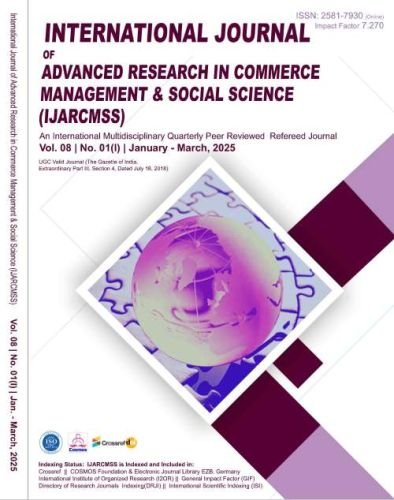Publisher :
Prof. (Dr.) S.S. Modi
Proprietor,INSPIRA
President, Inspira Research Association,
25, Sudama Nagar, Tonk Road, Jaipur - 302018
Mail Id: profdrssmodi@gmail.com

Impact Factor of Journal |
||
|---|---|---|
| Year | IJARCMSS | |
| 2024 | 7.270 | |
Title: COVER PAGE
Authors: Arnada Jamnong & Dr. Bhumiphat Gilitwala
![]() DOI: 10.62823/IJARCMSS/8.1(I).7115
DOI: 10.62823/IJARCMSS/8.1(I).7115
Title: EMOTIONS IN MOTION: THE ROLE OF INVESTORS’ SENTIMENT IN STOCK MARKET DYNAMIC
Authors: Jayashree D. Chaudhari & Dr. Nishant Ghuge
![]() DOI: 10.62823/IJARCMSS/8.1(I).7116
DOI: 10.62823/IJARCMSS/8.1(I).7116
Authors: Gurwinder Kaur
![]() DOI: 10.62823/IJARCMSS/8.1(I).7117
DOI: 10.62823/IJARCMSS/8.1(I).7117
Title: INDIA'S ECONOMIC DEVELOPMENT CHALLENGES
Authors: Dr. Sunita Sharma & Mr. Vivek Kumar Nagar
![]() DOI: 10.62823/IJARCMSS/8.(I).7118
DOI: 10.62823/IJARCMSS/8.(I).7118
Title: KAUTILYAN PRINCIPLES AND ITS RELEVANCE IN INDIA’S MISSION LIFE
Authors: Niranjan Roy
![]() DOI: 10.62823/IJARCMSS/8.1(I).7119
DOI: 10.62823/IJARCMSS/8.1(I).7119
Title: OPPORTUNITIES AND CHALLENGES OF RURAL TOURISM IN RAJASTHAN
Authors: Rahul Kumar Mehta
![]() DOI: 10.62823/IJARCMSS/8.1(I).7120
DOI: 10.62823/IJARCMSS/8.1(I).7120
Title: ROLE OF MARKETING COMMUNICATION IN INDIAN POLITICAL CAMPAIGN
Authors: Dr. Shreya Bhargav
![]() DOI: 10.62823/IJARCMSS/8.1(I).7121
DOI: 10.62823/IJARCMSS/8.1(I).7121
Title: INDIA’S SHIFT TO A CASHLESS ECONOMY: IS IT TRULY ECONOMICAL?
Authors: Madalsa Goswami
![]() DOI: 10.62823/IJARCMSS/8.1(I).7122
DOI: 10.62823/IJARCMSS/8.1(I).7122
Authors: Xiaoling Zhang, Dr. Siriwan Kitcharoen & Dr. Bhumiphat Gilitwala
![]() DOI: 10.62823/IJARCMSS/8.1(I).7123
DOI: 10.62823/IJARCMSS/8.1(I).7123
Title: ARTIFICIAL INTELLIGENCE IN HRM: A NEW ERA OF EFFICIENCY
Authors: Dheeraj Kumar Gautam
![]() DOI: 10.62823/IJARCMSS/8.1(I).7124
DOI: 10.62823/IJARCMSS/8.1(I).7124
Title: MANAGEMENT OF WORKING CAPITAL IN FERTILIZER INDUSTRY (IFFCO)
Authors: Sonika
![]() DOI: 10.62823/IJARCMSS/8.1(I).7125
DOI: 10.62823/IJARCMSS/8.1(I).7125